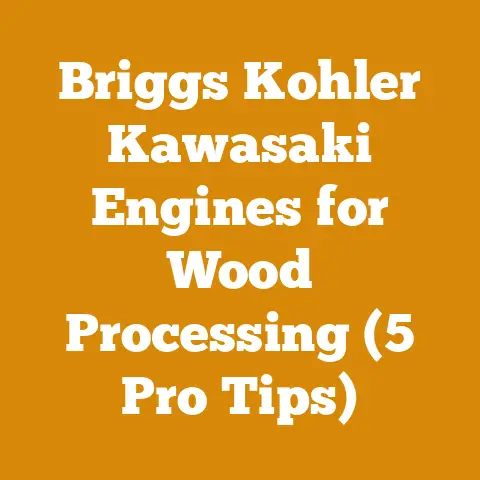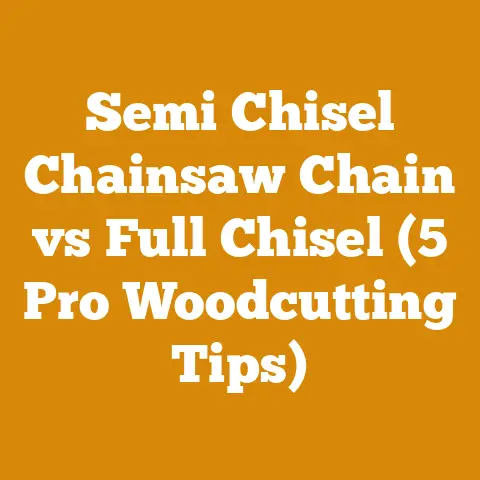Husqvarna 372XP Muffler Mod (3 Pro Woodcutting Hacks)
A simple muffler modification can unlock hidden horsepower and improve performance, but before we dive into the nuts and bolts (pun intended!), let’s talk about the bigger picture: how this mod fits into your overall woodcutting or firewood preparation budget.
Husqvarna 372XP Muffler Mod: 3 Pro Woodcutting Hacks
As someone who’s spent years wrestling with logs and chainsaws, I know firsthand that maximizing your equipment’s efficiency is crucial, especially when every cut counts against your bottom line.
Modifying the muffler on a Husqvarna 372XP is a popular upgrade that can significantly boost its performance, but it’s essential to weigh the benefits against the costs.
Why Modify a Husqvarna 372XP Muffler?
The stock muffler on the 372XP, like many chainsaws, is designed to meet stringent noise and emissions regulations.
While this is important, it also restricts the engine’s exhaust flow, which can limit power output.
A muffler modification aims to improve exhaust flow, allowing the engine to breathe easier and produce more power.
This translates to faster cutting speeds, especially in hardwoods, and improved overall performance.
The 3 Pro Woodcutting Hacks: Muffler Mod Options
There are a few common approaches to modifying the 372XP muffler.
Each has its own advantages and disadvantages in terms of cost, complexity, and performance gains.
The “Simple Hole” Mod: This is the most basic and cost-effective option.
It involves drilling additional holes in the existing muffler to increase exhaust flow.- Pros: Inexpensive, relatively easy to do with basic tools, noticeable performance improvement.
- Cons: Can be noisy, may not provide the maximum possible performance gain, potential for uneven exhaust flow.
-
The “Deflector Plate” Mod: This involves adding a deflector plate to the muffler to direct exhaust gases away from the operator and prevent scorching.
It often accompanies the “Simple Hole” mod. -
Pros: Directs exhaust effectively, helps prevent burns and scorching, relatively easy to install.
- Cons: Adds a small amount to the overall cost, requires some welding skills or access to a welder.
-
The “Aftermarket Muffler” Replacement: This involves replacing the stock muffler with a performance-designed aftermarket muffler.
-
Pros: Optimized exhaust flow for maximum performance gains, often made from durable materials, can look more professional.
- Cons: Most expensive option, requires removing and replacing the entire muffler assembly, potential for compatibility issues.
Cost Analysis of Each Mod
Let’s break down the costs associated with each modification option.
Keep in mind that these are estimates, and prices can vary depending on your location, the specific parts you choose, and whether you do the work yourself or hire a professional.
As I always say, “Measure twice, cut once,” and that applies to your budget too!
1. The “Simple Hole” Mod Cost Breakdown
- Materials:
- Drill bits (various sizes): $5 – $15
- High-temperature paint (optional, for rust prevention): $10 – $20
- Labor:
- DIY: Free (your time)
- Professional Mechanic: $25 – $50 (depending on hourly rate)
Total Estimated Cost: DIY: $5 – $35, Professional: $30 – $85
2. The “Deflector Plate” Mod Cost Breakdown
- Materials:
- Drill bits (various sizes): $5 – $15
- High-temperature paint (optional, for rust prevention): $10 – $20
- Steel plate (small piece for deflector): $5 – $10
- Welding rod/wire: $5 – $10
- Labor:
- DIY: Free (your time, assuming you have welding skills)
- Professional Welder: $50 – $100 (depending on hourly rate and complexity)
Total Estimated Cost: DIY: $25 – $55 (if you have welding equipment), Professional: $75 – $165
3. The “Aftermarket Muffler” Replacement Cost Breakdown
- Materials:
- Aftermarket Muffler: $50 – $150 (depending on brand and quality)
- New Gasket (recommended): $5 – $10
- Labor:
- DIY: Free (your time)
- Professional Mechanic: $25 – $50 (depending on hourly rate)
Total Estimated Cost: DIY: $55 – $160, Professional: $80 – $210
Performance vs. Cost: Which Mod is Right for You?
The best muffler mod for you depends on your budget, your skill level, and your desired performance gains.
- For the Budget-Conscious: The “Simple Hole” mod is the most affordable option and can provide a noticeable performance improvement.
If you’re comfortable drilling a few holes, it’s a great way to get started. - For the DIY Enthusiast: The “Deflector Plate” mod offers a good balance of performance and cost, but it requires some welding skills.
If you enjoy tinkering and have access to a welder, it’s a rewarding project. - For the Performance Seeker: The “Aftermarket Muffler” replacement is the most expensive option, but it offers the best potential performance gains.
Let’s zoom out and look at the other factors that contribute to your overall costs.1.
Timber Purchase or Harvesting CostsWhether you’re buying timber from a supplier or harvesting it yourself, this is often the biggest expense.
- Timber Purchase: Prices vary widely depending on the species, quality, and location.
As of late 2023/early 2024, prices for hardwood sawlogs in the US Southeast ranged from $400 to $800 per thousand board feet (MBF), while softwood prices were generally lower.
In Europe, timber prices have been volatile due to factors like the war in Ukraine and fluctuating demand, but generally, prices for spruce and pine sawlogs have been in the range of €80-€150 per cubic meter.
These are just averages; local market conditions can significantly impact prices.
I always recommend getting quotes from multiple suppliers and negotiating when possible. - Harvesting Costs: If you’re harvesting your own timber, you’ll need to factor in the cost of permits (if required), equipment rental (skidders, loaders), and labor.
Logging permits can range from a few dollars to several hundred dollars depending on the location and the size of the harvest.
Equipment rental can easily cost several hundred dollars per day.
Labor costs will depend on whether you’re doing the work yourself or hiring a logging crew.
2.
Tool Costs: Chainsaws, Splitters, and MoreBesides the chainsaw itself, you’ll need a variety of other tools for wood processing and firewood preparation.
- Chainsaws: As we’ve discussed, the Husqvarna 372XP is a popular choice for professional woodcutters, but there are many other options available.
The cost of a new professional-grade chainsaw can range from $800 to $1500. - Chainsaw Maintenance: Don’t forget to factor in the cost of chainsaw maintenance, including chain sharpening, bar oil, fuel, and replacement parts.
A dull chain can significantly reduce cutting efficiency and increase fuel consumption.
I recommend sharpening your chain regularly and using high-quality bar oil to prolong the life of your saw. - Log Splitters: If you’re preparing firewood, a log splitter can save you a lot of time and effort.
Manual log splitters are relatively inexpensive (around $100 – $300), but they require a lot of physical labor.
Gas-powered log splitters are more expensive (ranging from $1000 to $3000 or more), but they can split logs much faster and with less effort.
Electric log splitters are a good option for smaller jobs and indoor use. - Other Tools: You’ll also need other tools like axes, wedges, measuring tapes, and safety gear.
Safety gear is non-negotiable.
Always wear a helmet, eye protection, hearing protection, and chainsaw chaps when operating a chainsaw.
3.
Labor Costs: Logging Crew or Firewood HandlersIf you’re hiring a logging crew or firewood handlers, labor costs will be a significant expense.
- Logging Crew: The cost of hiring a logging crew will depend on the size of the crew, the type of work they’re doing, and the local market conditions.
According to the U.S.
Bureau of Labor Statistics, the median hourly wage for logging workers in May 2022 was $21.36.
However, wages can vary significantly depending on experience and location. - Firewood Handlers: If you’re selling firewood, you’ll need to factor in the cost of labor for cutting, splitting, stacking, and delivering the wood.
The cost of firewood handlers will depend on the local minimum wage and the amount of work required.
4.
Transportation CostsTransportation costs can add up quickly, especially if you’re hauling timber or firewood over long distances.
- Fuel: The cost of fuel will depend on the distance you’re traveling and the fuel efficiency of your vehicle.
Keep in mind that fuel prices can fluctuate significantly. - Vehicle Maintenance: Don’t forget to factor in the cost of vehicle maintenance, including oil changes, tire replacements, and repairs.
- Delivery Fees: If you’re selling firewood, you may need to charge delivery fees to cover your transportation costs.
5.
Drying and Storage CostsIf you’re preparing firewood, you’ll need to dry it properly before selling it.
- Drying Time: The amount of time it takes to dry firewood depends on the species of wood, the climate, and the stacking method.
Hardwoods generally take longer to dry than softwoods.
In a dry climate, firewood can dry in as little as six months.
In a humid climate, it may take a year or more.
As a rule of thumb, aim for a moisture content below 20% for optimal burning. - Storage Costs: You’ll need a place to store the firewood while it’s drying.
This could be a simple woodpile covered with a tarp, or a more elaborate shed or storage facility.
6.
Permits and RegulationsDepending on your location, you may need to obtain permits for logging or selling firewood.
- Logging Permits: Logging permits are typically required for commercial timber harvesting.
The cost of a logging permit will depend on the size of the harvest and the local regulations. - Firewood Sales Permits: Some jurisdictions require firewood sellers to obtain a permit or license.
The cost of a firewood sales permit is usually relatively low.
Case Study: Budgeting for a Small-Scale Firewood Business
Let’s look at a hypothetical case study to illustrate how to budget for a small-scale firewood business.
Scenario: You want to start a small firewood business selling seasoned hardwood.
You plan to purchase logs from a local supplier, cut and split the wood yourself, and sell it directly to customers.Assumptions:
- You purchase 10 cords of hardwood logs at $200 per cord.
- You use a Husqvarna 372XP chainsaw (already owned).
- You use a gas-powered log splitter (already owned).
- You dry the firewood for one year.
- You sell the firewood for $400 per cord.
Cost Breakdown:
- Timber Purchase: 10 cords x $200/cord = $2000
- Chainsaw Maintenance: $100 (chain sharpening, bar oil, fuel)
- Log Splitter Maintenance: $50 (fuel, oil)
- Transportation: $200 (fuel, vehicle maintenance)
- Permits: $50
- Labor: $0 (you’re doing the work yourself)
Total Costs: $2400
Revenue:
- 10 cords x $400/cord = $4000
Profit:
- $4000 (revenue) – $2400 (costs) = $1600
Analysis:
In this scenario, you would make a profit of $1600 on selling 10 cords of firewood.
However, this doesn’t factor in the value of your time.
If you spend 100 hours cutting, splitting, and stacking the wood, you’re only earning $16 per hour.
You’ll need to consider whether that’s a worthwhile return on your investment of time and effort.Practical Tips for Cost Optimization
Here are some practical tips for cost optimization in wood processing and firewood preparation:
- Shop Around for Timber: Get quotes from multiple suppliers and negotiate when possible.
Consider purchasing timber in bulk to get a better price. - Maintain Your Equipment: Regular maintenance can prolong the life of your equipment and prevent costly repairs.
- Sharpen Your Chains Regularly: A dull chain reduces cutting efficiency and increases fuel consumption.
- Dry Your Firewood Properly: Seasoned firewood burns more efficiently and produces more heat.
- Stack Your Firewood Efficiently: Proper stacking can improve airflow and speed up the drying process.
- Consider Alternative Heating Options: If you’re using firewood for heating, consider alternative heating options like wood pellets or natural gas.
- Sell Firewood in Bulk: Selling firewood in bulk can reduce your labor costs and transportation costs.
- Offer Delivery Services: Offering delivery services can increase your sales and attract new customers.
- Market Your Firewood Business: Promote your firewood business online and in your local community.
Calculations and Formulas
Here are some relevant calculations and formulas for wood processing and firewood preparation:
- Board Feet: A board foot is a unit of measurement for lumber.
It is equal to a piece of wood that is 1 inch thick, 12 inches wide, and 12 inches long.- Formula: (Thickness in inches x Width in inches x Length in inches) / 144
- Cords: A cord is a unit of measurement for firewood.
It is equal to a stack of wood that is 4 feet high, 4 feet wide, and 8 feet long.- Formula: Volume in cubic feet / 128
- Estimating Drying Time: The drying time for firewood depends on several factors, including the species of wood, the climate, and the stacking method.
As a general rule, hardwoods take longer to dry than softwoods.- Rule of Thumb: Allow at least six months for hardwoods to dry and three months for softwoods.
- Moisture Content: The moisture content of firewood is the percentage of water in the wood.
Seasoned firewood should have a moisture content below 20%.- Formula: ((Wet Weight – Dry Weight) / Dry Weight) x 100
Global Perspectives and Challenges
Small-scale loggers, firewood suppliers, and independent wood processors face a variety of challenges around the world.
These challenges include:- Fluctuating Timber Prices: Timber prices can fluctuate significantly due to factors like weather, economic conditions, and government regulations.
- Competition: Small-scale operators often face competition from larger companies with more resources.
- Environmental Regulations: Environmental regulations can be costly and time-consuming to comply with.
- Access to Markets: Small-scale operators may have difficulty accessing markets for their products.
- Lack of Financing: Small-scale operators may have difficulty obtaining financing for their businesses.
Actionable Takeaways and Next Steps
- Assess Your Needs: Determine your specific needs and goals for wood processing or firewood preparation.
- Develop a Budget: Create a detailed budget that includes all of your costs and revenues.
- Shop Around for Equipment: Compare prices and features of different equipment options.
- Maintain Your Equipment: Regular maintenance can prolong the life of your equipment and prevent costly repairs.
- Dry Your Firewood Properly: Seasoned firewood burns more efficiently and produces more heat.
- Market Your Business: Promote your business online and in your local community.
- Stay Informed: Stay up-to-date on industry trends and best practices.
Conclusion
Modifying the muffler on your Husqvarna 372XP can be a worthwhile investment, but it’s essential to consider the costs and benefits carefully.
By understanding the different modification options and their associated costs, you can make an informed decision that aligns with your budget and your performance goals.
Remember, a well-maintained chainsaw is a valuable asset, and a little bit of customization can go a long way towards maximizing its potential.
And as I always say, “A sharp chain and a sharp mind are the best tools in the woods!” - Timber Purchase: Prices vary widely depending on the species, quality, and location.






